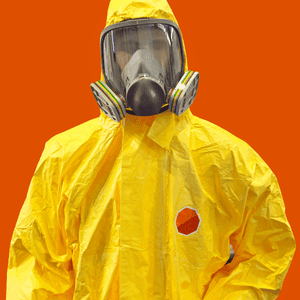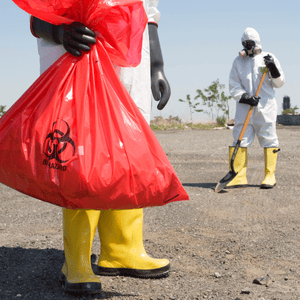When you hear the word “biohazard,” it might conjure up images of hazmat suits or sci-fi movie scenes. But in reality, biohazards are around us more than we realize and can range from everyday spills to serious health risks. At Black Hill Restoration, we know that understanding biohazards—what they are, the risks they pose, and the right way to handle them—can go a long way in protecting you, your family, and your community.
Let’s dive into the essentials you need to know about biohazardous materials: biohazard examples, the different types, cleanup, disposal, and the best ways to stay safe.
Biohazard Definition and Hazmat Meaning

To start, let’s get clear on some terms. Biohazard is short for “biological hazard,”. According to the Centers for Disease Control and Prevention (CDC), a biohazard refers to biological substances that pose a threat to the health of living organisms, primarily humans. This can include bacteria, viruses, medical waste, or even certain animals.
Hazmat—short for hazardous material—is any substance that poses a risk to health, property, or the environment. Biohazards are a type of hazmat, but the term hazmat also includes dangerous chemicals, radioactive materials, and toxic substances. When it comes to safety, understanding these definitions is critical, especially if you ever need professional help to handle a situation safely.
Common Biohazard Examples You Might Encounter
Biohazards aren’t just found in high-tech labs or medical facilities; they can be closer than you think, even at home or work. Here are a few common biohazardous materials that you might come across in your daily life:
Biohazardous materials:

- Blood and Bodily Fluids: Any exposure to blood or bodily fluids—like during an accident or health emergency—can carry risks of infection. This is why we use personal protective equipment (PPE) for all cleanups.
- Medical Waste: Sharps (like needles), bandages, and other materials from healthcare settings must be disposed of properly to avoid contamination and disease spread.
- Animal Waste and Carcasses: Even animal droppings can contain harmful pathogens. Bird and rodent droppings, for instance, can lead to respiratory illnesses.
- Mold and Fungi: Especially common in areas affected by water damage, mold growth can lead to respiratory issues and allergic reactions.
- Chemical Spills in Industrial Settings: Although these aren’t biological in nature, they still require a specialized hazmat response.
Situations That May Call for Biohazard Cleanup
In addition to these materials, certain situations require immediate and thorough biohazard cleanup due to the high risk of contamination and health hazards:
- Unattended Death: When someone passes away alone and is not discovered right away, the decomposition process releases biohazardous substances that require professional cleanup.
- Crime Scene Cleanup: Blood and other bodily fluids at crime scenes pose risks for disease transmission, necessitating specialized cleaning procedures.
- Hoarding Cleanup: In hoarding situations, the accumulation of items and waste can harbor mold, bacteria, and pest infestations, turning the environment into a biohazard.
- Sewage Backups: Raw sewage carries bacteria, viruses, and parasites, posing serious health risks that require professional cleanup.
- Drug Labs: Former drug labs or areas where illegal drugs have been used often contain toxic residues that are hazardous to health and must be decontaminated safely.
- Industrial Accidents: When chemicals or hazardous substances are spilled, a hazmat response is essential to ensure the safety of workers and the surrounding area.
Every one of these situations represents a potential health risk, and depending on the nature of the biohazard, it’s often best to call in a professional biohazard cleanup team like Black Hill Restoration. Our team is trained to handle even the most sensitive cleanup scenarios with care, professionalism, and a commitment to restoring safe environments.
Levels of Biohazards: Know the Risks and Protection Levels
Biohazards are classified by risk level, from Level 1 to Level 4, which helps determine the type of response needed for safe handling:
- Level 1 (Low Risk): These are the least dangerous biohazards, such as certain strains of E. coli used in research labs. They pose minimal risk to healthy individuals.
- Level 2 (Moderate Risk): Includes agents like Hepatitis B and MRSA, which are more harmful and require moderate precautions but generally aren’t life-threatening.
- Level 3 (High Risk): Agents like tuberculosis and anthrax fall under this category, which requires special handling and protective equipment to prevent serious health risks.
- Level 4 (Extreme Risk): The most dangerous biohazards, such as Ebola, demand maximum containment measures and full hazmat biohazard suits.
Knowing the level of biohazard can help determine the appropriate steps and equipment for safe handling. At Black Hill Restoration, we handle cleanup processes based on these levels, ensuring everyone’s safety.
Hazmat Biohazard Suit: Essential Gear for Safety

If you’ve ever seen a hazmat suit, you know they’re serious business. These suits are designed to protect workers from hazardous exposure by covering the entire body, keeping contaminants out. But when are these suits necessary?
For high-risk biohazard levels, especially Level 3 and Level 4, our technicians suit up. A hazmat biohazard suit is more than just a costume—it’s life-saving equipment that seals out dangerous pathogens, chemical splashes, and airborne hazards. At Black Hill Restoration, we take every safety precaution when handling dangerous biohazards, so you can feel confident that any cleanup is done with the utmost care and expertise.
What Is a Biohazard Bag and How Is It Used?

A biohazard bag is a specially designed bag used for the disposal of biological waste. These bags, often bright red or yellow, indicate that the waste inside contains potentially infectious materials and must be handled with care.
Different colors can signal different risks. For instance:
- Red bags: Typically used for infectious waste, including bodily fluids and tissues.
- Yellow bags: Used for chemical-contaminated waste or materials that may contain infectious agents.
Biohazard bags are a crucial part of safe biohazard disposal, as they allow for the safe transportation and disposal of waste without contamination. Our team at Black Hill Restoration uses these bags for cleanup projects, ensuring that hazardous materials are properly contained and disposed of following safety guidelines.
Safe Disposal of Biohazard Waste Bags: What You Need to Know
Proper disposal of biohazard waste bags is key to preventing contamination and protecting public health. Whether you’re handling small amounts at home or dealing with waste in a medical facility, these steps are critical:
- Label and Seal: Always label biohazard waste bags, seal them tightly, and store them away from other waste.
- Transport Carefully: Use designated transport containers and ensure they are handled by trained professionals.
- Work with Licensed Disposal Services: Disposal of biohazard waste isn’t a DIY project. Improper disposal can lead to health risks, fines, and environmental harm. Black Hill Restoration is licensed to safely dispose of biohazardous waste in compliance with federal and local regulations.
Disposal might seem straightforward, but it’s a complex process to manage safely. Our team ensures that biohazard waste bags are transported and disposed of properly, removing the burden from you.
Biohazard Cleanup: Why You Should Call in the Pros
Biohazard cleanup is no small task, and it’s one that you shouldn’t have to handle alone. Blood, bodily fluids, mold, and chemical spills can present health risks that require special equipment and expertise. Here’s why a professional cleanup team can make all the difference:
- Safety First: Our team is trained to handle and dispose of biohazards safely, using the correct PPE and following strict protocols.
- Specialized Equipment: We use specialized tools and cleaning agents that effectively sanitize the area, preventing cross-contamination and ensuring safe results.
- Peace of Mind: Biohazard cleanup can be distressing. Having professionals handle the job allows you to focus on your family, your business, or your recovery without added stress.
When you call Black Hill Restoration, we take every precaution to restore your property to safe, livable conditions. From accident cleanup to mold remediation, we’re here to help with compassion, professionalism, and respect for your property.
Stay Safe and Protected Around Biohazards
Understanding biohazards is essential to maintaining a safe environment, whether at home or work. Biohazards are more than just science fiction; they’re real, and knowing how to identify, handle, and dispose of them can help you avoid unnecessary risks.
Remember, not every biohazard requires a full hazmat team, but any significant exposure—like medical waste or mold contamination—calls for professional attention. At Black Hill Restoration, we’re here to provide expert biohazard cleanup and disposal services, bringing you peace of mind when you need it most.Need professional help with biohazard cleanup? Contact Black Hill Restoration today, and let our team handle the job safely and efficiently, so you can rest easy.

